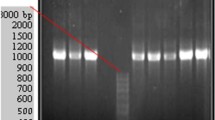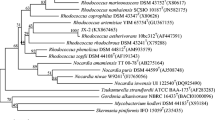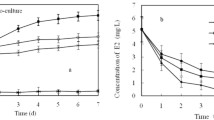Abstract
The natural estrogen 17β-estradiol (E2) is a major endocrine disruptor, with adverse effects on wildlife and humans. The aim of this study was to isolate microorganisms able to effectively remove E2 from wastewater. Accordingly, five E2-degrading strains of bacteria were isolated from activated sludge collected from a wastewater treatment plant. Based on their 16S RNA gene sequences, these five strains belonged to the genus Bacillus. All five isolates were capable of converting E2 to estrone (E1), greatly reducing total estrogenic activities in wastewater during E2 biodegradation. However, only two strains (strain E2Y1 and E2Y4) were able to further transform E1, whereas it accumulated in the culture medium of the other isolates. Among all isolates, strain E2Y4, with 100% of the 1,400 bp 16S RNA gene matched that of B. subtilis CICC10075, exhibited the highest E2 and E1 degradation capacities, degrading 1 mg E2/l completely within 4 days and further transforming 40% of the metabolite E1. Furthermore, the E2 degradation rates of strain E2Y4 increased with increasing initial concentrations of the steroid, with a high degradation capacity maintained even at initial concentrations up to 50 mg/l. These results demonstrate the potential significance of strain E2Y4 in biological remediation applications.






Similar content being viewed by others
References
Aerni HR, Kobler B, Rutishauser BV, Wettstein FE, Fischer R, Giger W, Hungerbuehler A, Marazuela MD, Peter A, Schoenenberger R, Voegeli AC, Suter MJF, Eggen RIL (2004) Combined biological and chemical assessment of estrogenic activities in wastewater treatment plant effluents. Anal Bioanal Chem 378:688–696
Andersen H, Siegrist HR, Halling-sørensen B, Ternes TA (2003) Fate of estrogens in a municipal sewage treatment plant. Environ Sci Technol 37:4021–4026
Baronti C, Curini R, D′Ascenzo G, Di Corcia A, Gentili A, Samperi R (2000) Monitoring natural and synthetic estrogens at activated sludge sewage treatment plants and in a receiving river water. Environ Sci Technol 34:5059–5066
Falconer IR, Chapman HF, Moore MR, Ranmuthugala G (2006) Edocrine-disrupting compounds: a review of their challenge to sustainable and safe water supply and water reuse. Environ Toxicol 21:181–191
Fujii K, Kikuchi S, Satomi M, Ushio-Sata N, Morita N (2002) Degradation of 17β-estradiol by a gram-negative bacterium isolated from activated sludge in a sewage treatment plant in Tokyo, Japan. Appl Environ Microbiol 68:2057–2060
Gaido KW, Leonard LS, Lovell S, Gould JC, Babai D, Portier CJ (1997) Evaluation of chemicals with endocrine modulating activity in a yeast-based steroid hormone receptor gene transcription assay. Toxcol Appl Pharmacol 143:205–212
Johnson AC, Sumpter JP (2001) Removal of endocrine-disrupting chemicals in activated sludge treatment works. Environ Sci Technol 35:4697–4703
Johnson AC, Williams RJ (2004) A model to estimate influent and effluent concentrations of estradiol, estrone and ethinylestradiol at sewage treatment works. Environ Sci Technol 38:3649–3658
Joss A, Andersen H, Ternes TA, Richle PR, Siegrist H (2004) Removal of estrogens in municipal wastewater treatment under aerobic and anaerobic conditions: consequences for plant optimization. Environ Sci Technol 38:3047–3055
Kolodiej EP, Gray JL, Sedlak DL (2003) Quantification of steroid hormones with pheromonal properties in municipal wastewater effluent. Environ Toxicol Chem 22:2622–2629
Li J, Li N, Ma M, Giesy JP, Wang ZJ (2008) In vitro profiling of the endocrine disrupting potency of organochlorine pesticide. Toxicol Lett 183:65–71
Liu ZH, Kanjo Y, Mizutani S (2009) Removal mechanisms for endocrine disrupting compounds (EDCs) in wastewater treatment—physical means, biodegradation, and chemical advanced oxidation: a review. Sci Total Environ 407:731–748
Ma M, Li J, Wang ZJ (2005) Assessing the detoxication efficiencies of wastewater treatment processes using a battery of bioassays/biomarkers. Arch Environ Contam Toxicol 49:480–487
Ojanotko-Harri A, Laine M, Tenovuo J (1991) Metabolism of 17 beta-estradiol by oral Streptococcus mutans, Streptococcus sanguis, Bacillus cereus and Candida albicans. Oral Microbiol Immunol 6:126–128
Pauwels B, Wille K, Noppe H, De Brabander H, Van de Wiele T, Verstraete W, Boon N (2008) 17α-ethinylestradiol cometabolism by bacteria degrading estrone, 17β-estradiol and estriol. Biodegradation 19:683–693
Purdom CE, Hardiman PA, Bye VJ, Eno NC, Tyler CR, Sumpter JP (1994) Estrogenic effects of effluents from sewage treatment works. Chem Ecol 8:275–285
Quan CS, Liu Q, Tian WJ, Kikuchi J, Fan SD (2005) Biodegradation of an endocrine-disrupting chemical, di-2-ethylhexyl phthalate, by Bacillus subtilis No. 66. Appl Microbiol Biotech 66:702–710
Sóle M, Lopez de Alda MJ, Castillo M, Porte C, Ladegaard-Pedersen K, Barcelo D (2000) Estrogenicity determination in sewage treatment plants and surface waters from the Catalonian area (NE Spain). Environ Sci Technol 34:5076–5083
Ternes TA, Stumph M, Mueller J, Haberer H, Wilken RD, Servos M (1999) Behavior and occurrence of estrogens in municipal sewage treatment plants—I. Investigations in Germany, Canada and Brazil. Sci Total Environ 225:81–90
Vethaak AD, Lahr J, Kuiper RV (2002) Estrogenic effects in fish in the Netherlands: some preliminary results. Toxicology 181:147–150
Weber S, Leuschner P, Kampfer P, Dott W, Hollender J (2005) Degradation of estradiol and ethinyl estradiol by activated sludge and by activated sludge and by a defined mixed culture. Appl Environ Microbiol 67:106–112
Xia Y, Min H, Rao G, Lv ZM, Liu J, Ye YF, Duan XJ (2005) Isolation and characterization of phenanthrene-degrading Sphingomonas paucimobilis strain ZX4. Biodegradation 16:393–402
Yoshimoto T, Nagai F, Fujimoto J, Watanabe K, Mizukoshi H, Makino T, Kimura K, Saíno H, Sawada H, Omura H (2004) Degradation of estrogen by Rhodococcus zopfii and Rhodococcus equi isolates from activated sludge in wastewater treatment plants. Appl Environ Microbiol 70:5283–5289
Yu CP, Roh H, Chu KH (2007) 17β-estradiol-degrading bacteria isolated from activated sludge. Environ Sci Technol 41:486–492
Zhang ZL, Hibberd A, Zhou JZ (2006) Optimisation of derivatisation for the analysis of estrogenic compounds in water by solid-phase extraction gas chromatography-mass spectrometry. Anal Chem Acta 577:52–61
Acknowledgments
This work was funded by the Natural Science Foundation of Zhejiang Province (Grant No. Y506237), and Analysis and Testing Foundation from Science and Technology Department of Zhejiang Province (Grant No. 2008F70014).
Author information
Authors and Affiliations
Corresponding author
Rights and permissions
About this article
Cite this article
Jiang, L., Yang, J. & Chen, J. Isolation and characteristics of 17β-estradiol-degrading Bacillus spp. strains from activated sludge. Biodegradation 21, 729–736 (2010). https://doi.org/10.1007/s10532-010-9338-z
Received:
Accepted:
Published:
Issue Date:
DOI: https://doi.org/10.1007/s10532-010-9338-z




